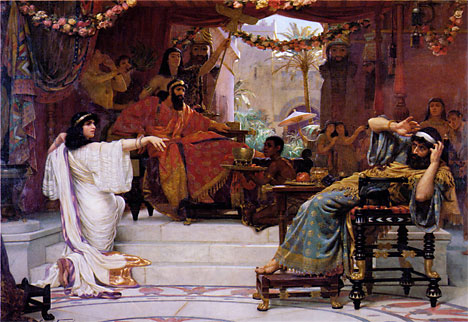Esther and the Ten Words
The systematic typology of the Bible Matrix allows us to follow the structures of the Torah thoughout the rest of the Bible. Here’s something that links the Restoration era with the book of Deuteronomy.
Concerning Esther’s entry into the Emperor’s beauty contest, James Jordan writes:
“[W]hat is Mordecai’s problem? It seems to be this: He is a schemer who seeks to acquire influence through political manoeuvering rather than through faith in God. When the king’s men round up pretty girls as potential queen candidates, Esther is among them. We can dismiss the notion that gangs of Persians went around seizing all the pretty girls. No, Esther shows up as a candidate because Mordecai wanted her to.
She only did what he told her (2:20). Mordecai tells her to conceal her Jewishness, and she obeys him even after she was married and owed her allegiance to her husband (compare Psalm 45). In this way, Mordecai causes Esther to sin.
We do not know why this man wanted to keep his Jewishness and that of his niece a secret. We know full well that this king had allowed the Jews in Jerusalem to rebuild their temple (Ezra 6). So, why conceal one’s Jewishness? There is absolutely no evidence of any anti-Jewish prejudice in the ancient world — we may not read European history back into Biblical history.
So, we don’t know. What we can see, however, is that whatever else good might have been part of Mordecai’s personal makeup, he was playing a political game. [1]
This theory might seem arbitrary, but Jordan’s “mere assertions” have an uncanny habit of playing out as one does further study. There is no more than circumstantial evidence in the text. Or is there?
Surely Mordecai’s “coerced” presentation of Esther near the beginning of the narrative chiastically mirrors Esther’s willing presentation of herself near the end. Despite Mordecai’s “threat” of the possible disaster, the final choice was left up to Esther herself. The external law had become internal. The first “robing” was Delegation (Hierarchy), the last was Vindication (Sanctions). From The Covenant Key:
We saw this exact pattern in Bible Matrix concerning Joseph. In his first cycle, he receives his robe of authority at Division (Hierarchy). At Conquest (Sanctions), the robe is stolen, torn and covered with blood. In this initial cycle, the Covenant pattern is corrupted. It was Joseph who was supposed to execute Sanctions against his brothers. Instead, he was made the scapegoat.
Of course, we see this pattern reversed at the end of the narrative. He tests his brothers with, among other things, a cup, to see whether or not the “wilderness” years have transformed them. He discovers internal Law. When he reveals his face, the Veil of Joseph’s Egyptian office is opened and he is vindicated. [2]
Joseph represented the Covenant Head, and Moses the Body. Daniel represented the Head of a New Covenant (the one predicted by Jeremiah [3]), but Esther represented the Body. The women in the Emperor’s harem represented the nations — both historically and typologically. Babylon had seized them all, disempowered them, and put them under tribute as his “chattels.” But this new king of kings viewed them differently.
The book of Esther retells the entire story. Israel was like Vashti who refused to submit to her Covenant husband and was exiled before her insubordination spread to every household. That Old Covenant is dead, and a New Covenant is to be made.
This emperor is a better Solomon than Solomon’s successors were. He rules in a higher court — a “Melchizedekian” one of all nations – and as Christ He chooses Israel above all the other nations. Initially, He chooses her because of her outward beauty. But later, He chooses her because of her courage and wisdom — inward beauty (2 Tim. 2:9).
Esther is Israel. She is transformed by holy fire. This new Israel is not simply a restoration of the old, and here is where we see a reflection of the process in the Torah. In Exodus, the Ten Commandments include a man’s wife as one of his chattels that must not be coveted. Israel then passes through the “holy fire” in Numbers, and the Law is repeated to a new generation. But in Deuteronomy, the “wife” is elevated from simply being part of the household to being a co-regent over the household. This is the difference between the priesthood of Aaron (Israel) and the priesthood of Christ (the Church), the Law of Moses and the Law of the Spirit. One is a household of servants and children. One is a household of sons and wise men, which brings us to New Covenant baptism.
The book of Esther follows the “Tabernacle” matrix, and there is baptism typology in the narrative. It corresponds to the Laver, and it is when Esther robes herself and bravely stands as a martyr (witness) on the Emperor’s “crystal sea.” [4] She is then no longer one among many, nor even merely an honoured wife. She, like the church, is accepted as an advisor/mediator, and is instrumental in taking vengeance upon those who sought her destruction.
____________________________________
[1] James B. Jordan, The Astounding Adventures of Myrtle Morningstar, Part 3: Introducing the Troublemaker, BIBLICAL HORIZONS No. 208, March 2010. Available from www.biblicalhorizons.com
[2] Bible Matrix II: The Covenant Key, p. 223.
[3] See Jeremiah was a Bullfrog?
[4] Notice Peter doing exactly the same thing after spotting the resurrected Christ on the beach.


























